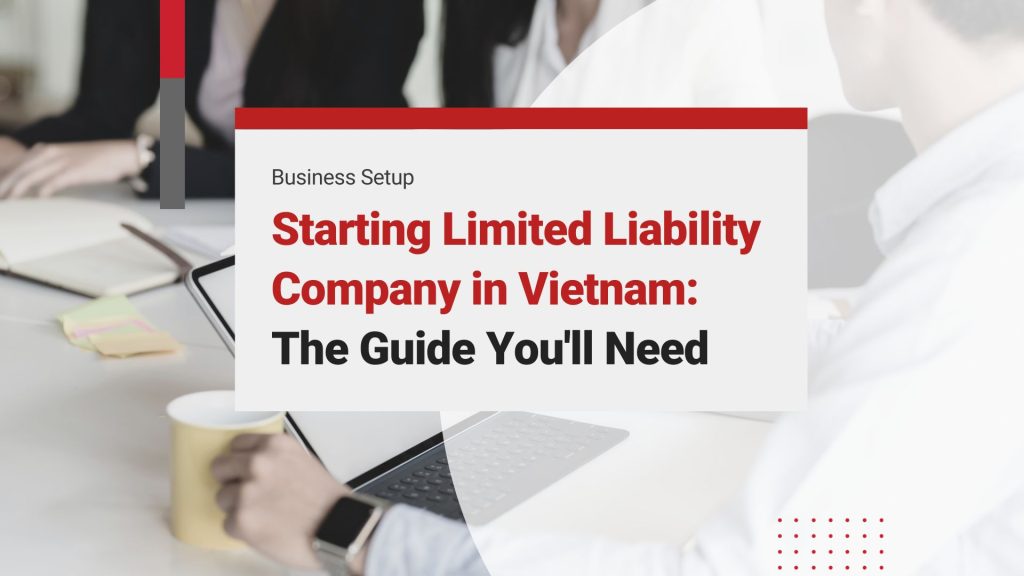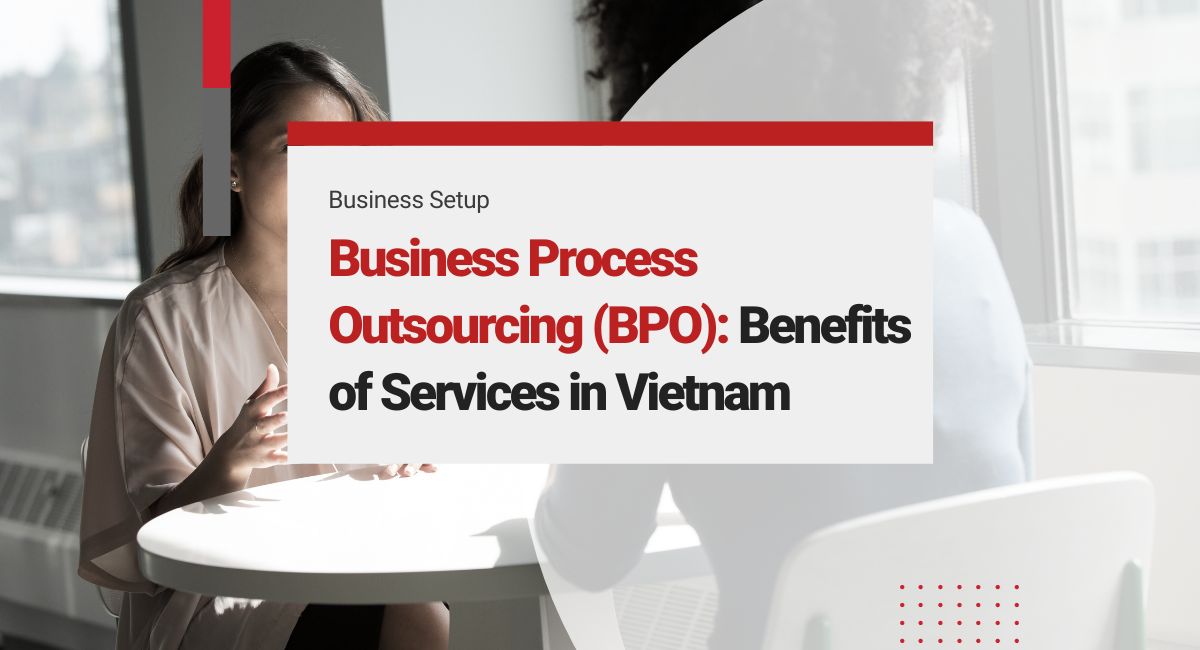The expanding wealth, rising middle-income group, larger young population, increased mobility, urbanization, and changing consumer attitudes are all indicators of Vietnam’s dynamic business climate. The modern business environment is preferred by entrepreneurs to open up new business possibilities and breakthroughs. Choosing to establish a limited liability company (LLC) in Vietnam is a significant and profitable decision, regardless of your size as a company or as an entrepreneur.
This guide will help foreign investors, entrepreneurs, and enterprises looking to expand their operations into Vietnam’s emerging market. We’ll provide you with all the essential information on LLCs, including their benefits, their variations, and the stages and procedures for starting and operating them. Everything you find below is based on over a decade of experience in market entry services, helping foreigners find new opportunities across Asia.
Invest in Vietnam? Check out InCorp Vietnam’s Company Incorporation Services in Vietnam
Definition of Limited Liability Company
LLC is a common abbreviation for Limited Liability Companies. This type of legal entity is often the most straightforward approach to launching a business in Vietnam, as it also protects your invested assets. In other words, the responsibility of a shareholder in an LLC is only capped at the value of their shares and does not extend to their private assets.
As Vietnam’s most popular legal entity, many choose Limited Liability Companies for a variety of other reasons as well: high transparency in operations, fast incorporation process with reduced paperwork, low operating costs, and much more. LLCs will offer you the most value with your investment with minimal risks.
Read More: Doing Business in Vietnam as a Foreigner: What, Where, Why, How?
Reasons to Start a Limited Liability Company in Vietnam vs Other Countries in Asia
Reduced Operating Costs
With a young labor force and job market, Vietnam has overall lower pay and lower operating costs than other nations (roughly half of China’s rates, for example). Additionally, it explains why Vietnamese goods are considerably less expensive than those from other nations.
Growth Opportunities Ready for Taking
Although the quality of Vietnamese products is improving so they can compete in the international market, there are still numerous goods and services that are not up to standard. Investors can tap into these areas and are likely to be successful if they conduct adequate market research and analysis for in-demand yet subpar goods and services. As a result, a variety of industries in Vietnam are drawing more and more international capital.
Benefits of Starting an LLC vs Other Legal Entities
Compared to other types of entities in Vietnam an LLC has the most simplified structure and is the easiest one to set up. This is especially true if your company is an SME (Small & Medium Enterprise) run by one or a few shareholders. Additional benefits are listed below:
- Protection of Personal Assets: The personal assets of its members are protected in the event of financial difficulties faced by the company. If the company faces legal actions or debt collection, neither the government, banks, nor creditors can seize the personal assets of individual members.
- Reduction of Paperwork: Compared to larger firms and entities in Vietnam, an LLC can greatly reduce the amount of process and operating paperwork involved in its day-to-day operations. This streamlines administrative tasks and increases operational efficiency.
- Continuity of Operations: Even if a shareholder or multiple shareholders pass away, an LLC can continue its operations without disruption. The company’s existence is not dependent on the individuals involved, ensuring continuity and stability in the business.
- Access to Funding: LLCs offer growth potential with easy funding from investors and financial institutions, enabling companies to seize growth opportunities and expand effortlessly.
- Avoidance of Double Taxation: LLCs prevent double taxation by taxing profits at the individual shareholder level, resulting in tax savings and improved financial efficiency.
- Enhanced Credibility: LLCs enhance company credibility through transparency, gaining trust from stakeholders such as customers, partners, and investors, which opens doors to better business relationships and opportunities.
Business Structure of an LLC
If you are considering setting up a limited liability company, doing in-depth research on its legal framework and limitations is a must.
All LLCs in Vietnam are classified into two distinct types based on how many members it has. According to Vietnam’s incorporation regulations, a single-member LLC can only have one member at the time of formation, if not it will become a multi-member LLC. However, a multi-member LLC cannot exceed 50 members.
We made the most detailed step-by-step guide for Company Incorporation in Vietnam for investors, now available as an interactive checklist:

Single-member LLC
Consists of one member (who is also the company’s owner). This member is liable for all the company’s liabilities and debts — only to the extent of the capital he or she invests.
According to the Law on Enterprises (2020), a company’s owner shall be the President, who may concurrently hold the position of Director/General Director or hire another person as the Director/General Director. This position can designate a board of members and dismiss members from it.
The owner of the company is entitled to the following rights:
- Draw up and revise the company’s charter;
- Decide the company’s annual business plan and development strategy;
- Decide the company’s organizational structure; designate, and dismiss the company’s executives and controllers;
- Decide the company’s investment projects;
- Decide solutions for market development, marketing, and technology;
- Approve contracts for borrowing, lending, sale of assets, and other contracts prescribed by the company’s charter, whose value is at least 50% of the total assets written in the latest financial statement (or a smaller ratio or value specified in the company’s charter);
- Ratify the company’s annual financial statements;
- Decide increase or decrease in the company’s charter capital, transfer part or all of the company’s charter capital to another organization or individual; decide issuance of bonds;
- Decide establishment of subsidiary companies and contribution of capital to other companies;
- Organize the supervision and assessment of the company’s performance;
- Decide the use of profits after the company’s tax liabilities and other financial obligations have been fulfilled;
- Decide the company’s reorganization, dissolution, or file for bankruptcy;
- Recover all assets of the company after the dissolution or bankruptcy process is complete;
- Other rights prescribed by this Law and the company’s charter.
The Director/General Director, if not the same person as the owner, is allowed to:
- Organize the implementation of resolutions and decisions of the Board of Members or the company’s President;
- Decide everyday operating issues of the company;
- Organize the implementation of the company’s business plans and investment plans;
- Issue the company’s rules and regulations;
- Designate and dismiss the company’s executives, except those within the jurisdiction of the Board of Members;
- Enter into contracts in the company’s name, except those within the jurisdiction of the President of the Board of Members or the company’s President;
- Propose the company’s organizational structure;
- Submit annual financial statements to the Board of Members or the company’s President;
- Propose plans for the use of profits or settlement of business losses;
- Recruit employees;
- Other rights and obligations are specified in the company’s charter and the employment contract.
Moving forward, should enterprises want to change their business type (from single-member to multi-member LLC), they are obliged to follow the order and procedures, and time limit prescribed by Vietnamese Law. For foreign-invested companies, when converting the type of enterprise, the following steps must be followed:
- Step 1: Change IRC. Time limit for processing dossiers: 15 days from the date of receipt of complete and valid dossiers
- Step 2: Change ERC. Time limit for processing dossiers: 03 days from the date of receipt of complete and valid dossiers
Multi-Member LLC
Two or more (up to 50 people) members form a multi-member LLC. As members of a multi-member LLC, they are given member rights including attending the board of members’ meeting, voting rights that are in proportion to their capital investment, provided shares and profits that are in proportion to their capital investment, and given priority for an extra capital contribution.
Read Related: Everything You Need To Know About Company Incorporation in Vietnam
As stated in the Law on Enterprises (2020), the company is allowed to transfer the capital contribution to the remaining members or non-members, but the conditions and method of transfer must comply with the provisions of the law. Conversely, a member is entitled to request the company to repurchase that member’s stake if that member has voted against a resolution or decision of the Board of Members on the following issues:
- Amendments to regulations of the company’s charter on rights and obligations of members and the Board of Members;
- Reorganization of the company;
- Other issues prescribed by the company’s charter.
Similar to a single-member LLC, when the board chooses a Director/General Director, he/she could be outside the company (i.e. not necessarily a member of the board).
The Board of Members has the following rights and obligations:
- Decide the company’s annual business plan and development strategy;
- Decide increase or decrease in charter capital, time, and method for raising more capital; issuance of bonds;
- Decide investments in the company’s development projects; solutions for market development, marketing, and technology transfer;
- Approve contracts for borrowing, lending, sale of assets, and other contracts prescribed by the company’s charter, the value of the contracts is at least 50% of the total assets written in the latest financial statement (or a smaller ratio or value specified in the company’s charter);
- Elect and dismiss the President of the Board of Members; designate, dismiss, sign, and terminate contracts with the Director/General Director, chief accountant, controllers, and other executives specified in the company’s charter;
- Decide the salaries, remunerations, bonuses, and other benefits of the President of the Board of Members, Director/General Director, chief accountant, controllers, and other executives specified in the company’s charter;
- Ratify annual financial statements, plans for use and distribution of profits or settlement of losses;
- Decide the company’s organizational structure;
- Decide the establishment of subsidiary companies, branches, and representative offices;
- Revise the company’s charter;
- Decide reorganization of the company;
- Decide dissolution or file bankruptcy for the company;
- Other rights and obligations are prescribed by Law and the company’s charter.
The Director/General Director of a multi-member LLC can:
- Organize the implementation of resolutions and decisions of the Board of Members;
- Decide everyday operating issues of the company;
- Organize the implementation of the company’s business plans and investment plans;
- Issue the company’s rules and regulations unless otherwise prescribed by the company’s charter;
- Designate, and dismiss the company’s executives, except those within the jurisdiction of the Board of Members;
- Enter into contracts on behalf of the company, except those within the jurisdiction of the President of the Board of Members;
- Propose the company’s organizational structure;
- Submit annual financial statements to the Board of Members;
- Propose plans for the use and distribution of profits or settlement of business losses;
- Recruit employees;
- Other rights and obligations specified in the company’s charter, resolution and decisions of the Board of Members, and his/her employment contract.
Phase 1: Registering a Limited Liability Company in Vietnam
Upon entering Vietnam’s market, you and your company will be legally required to carry out these procedures.
Initial Incorporation
- Obtain legalized copies of foreign documents from your home country. These documents can include passports, bank statements, etc. Time taken: likely 7-14 business days.
- Lease an office address. The address must be located in Vietnam and must be an office building, house, or virtual office (i.e. not in a residential apartment building). Time taken: 1-3 business days.
- Submit all the above documents to apply for an Investment Registration Certificate (IRC). At this step, you must also appoint a Legal Representative (or Nominee Director), who must be a resident of Vietnam. Time taken: 35-40 business days.
- Submit the IRC to obtain an Enterprise Registration Certificate (ERC), thereby officially establishing your business. Time taken: 7 business days.
- Engrave the company’s official seal and declare its use to the government. Time taken: 7 business days.
After this stage, your company will become an official legal entity.
Post-incorporation Initial Compliance
- Submit initial tax registration to the tax authorities. Time taken: 7 business days.
- Open your company’s bank account and submit evidence of the investment balances. Time taken: 1-3 business days.
- Inject investment capital into the bank account. Time taken: within 90 days of the ERC issuance date.
- Install physical company signs at your business location (automatically done for virtual offices). Time taken: 2-5 business days.
- Obtain any other license or certificate required for your specific business sector.
- Register an e-signature for online tax payments. Time taken: 3-7 business days.
- Submit a declaration of business license fee. Time taken: 1-3 business days.
These steps can be done simultaneously or in any order. After this stage, your company will be able to legitimately do business.
Phase 2: Establishment of Operations
Now that your company has started its operations in Vietnam, it must be aware of ongoing matters of legal compliance in tax & accounting, human resources & payroll (and immigration compliance).
Tax & Accounting
- Declare Personal Income Tax (PIT) after paying your employees’ salary.
- Declare your business’ Value Added Tax (VAT) and Business License Tax annually.
- Submit Corporate Income Tax (CIT) at the end of each quarter.
- Submit any other sector-specific taxes, e.g. special consumption tax, environmental protection tax, import & export taxes.
- Conduct and submit a report of an FDI Company Yearly Audit, carried out with an independent auditor.
HR & Payroll
- Monthly tasks: Calculate, adjust, and contribute regulatory insurance; report and track PIT for employees; ensure internal procedures are compliant (labor contract signing; salary adjustment, etc.); consult HR about employment regulation changes (if any).
- Yearly tasks: Submit Labor Declaration Report, finalize yearly PIT, declare company’s internal regulation.
- Recruiting employees.
Immigration Compliance
- Apply for Work Permits and/or Temporary Residence Cards (TRCs).
- Apply for a Business Visa or Investor Visa.
Phase 3: Restructuring Your Vietnamese Company
This stage goes further down the line in an LLC’s development, as companies will only undergo restructuring if and when they need to.
Restructuring refers to adaptations of an established company to changes & challenges such as going public or shifting business strategies.
- Ownership transfer: Many investors or startups begin with a plan to grow their business to its full potential before selling it for great profit. There are many ways this can happen: sell the business, reapportion its shares, or lease it.
- Mergers & acquisitions (M&A): This can include a friendly takeover (where the acquiring company offers a premium on the acquired shares) or a hostile takeover (where the acquiring company buys shares from a public stock exchange).
- Legal restructuring (converting to another entity): When shareholder numbers exceed 50 people, the company may choose to become a Joint-Stock Company (JSC). This can allow it to go public (provided capital requirements are met).
- Dissolution: Liquidation, in other words clearing and settling the company’s assets and liabilities, is the only way for businesses in Vietnam to be able to come to the end of their legal existence.
Ready to start your own LLC in Vietnam?
Navigating the paperwork and bureaucracy (which Vietnam is famous for) is no easy task. The legal infrastructure has many grey areas, and the language barrier can also be a hindrance, taking up your company’s time and resources. It helps to have a partner that knows the ins and outs of every stage in the process. With the right assistance, you can jumpstart your incorporation process and be up and ready in less than 2 months.
About Us
InCorp Vietnam is a leading provider of global market entry services. We are part of InCorp group, a regional leader in corporate solutions, that encompasses 8 countries in Asia-Pacific, headquartered in Singapore. With over 1,100 legal experts serving over 15,000 Corporate Clients across the region, our expertise speaks for itself. We provide transparent legal consulting, setup, and advice based on local requirements to make your business perfectly fit into the market with healthy growth.
Don’t take our word for it. Read some .
Verified by
Ian Comandao
Business Consulting Manager at InCorp Vietnam
Ian is a sales and marketing professional who has worked over 15 years in key accounts management.






